#endosperm
Explore tagged Tumblr posts
Text
During cereal endosperm development, the triploid primary endosperm nucleus undergoes a series of mitotic divisions without cytokinesis, and the nuclei migrate to the periphery of the central cell, which also contains a large central vacuole (Figure 21.26, see parts A-D). As in the Arabidopsis coenocyte, each of nuclei is surrounded by radially arranged microtubules (see Figure 21.26E). Anticlinal walls form initially between adjacent nuclei, resulting in the tubelike alveolar cells, with the open end pointing toward the central vacuole (see Figure 21.26F). (...) The innermost layer of daughter cells remains alveolar in structure, and continues to divide periclinally until cellularization is complete (see Figure 21.26G and H). The most important source of starchy endosperm cells is the interior cells of the cell files that are present at the completion of endosperm cellularization (see Figure 21.26H).
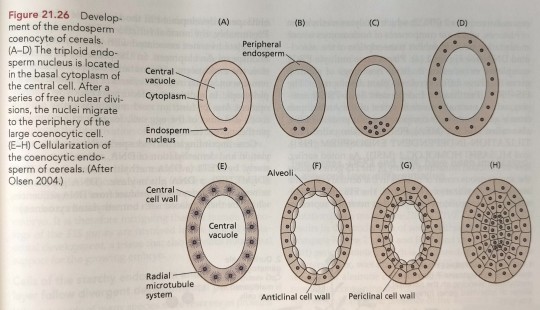
"Plant Physiology and Development" int'l 6e - Taiz, L., Zeiger, E., Møller, I.M., Murphy, A.
#book quotes#plant physiology and development#nonfiction#textbook#triploid#endosperm#mitosis#cell division#cell differentiation#plant cells#cytokinesis#vacuole#arabidopsis#coenocyte#microtubule#anticlinal#alveoli#daughter cells
3 notes
·
View notes
Text
So I just wanted to know if wheat was technically a starch bc idk when I think of starch I just think of potatoes but uh

Endo- endo what?
0 notes
Text
The seed coat arises from maternal integuments, but its development is regulated by the endosperm (Figure 21.29).


"Plant Physiology and Development" int'l 6e - Taiz, L., Zeiger, E., Møller, I.M., Murphy, A.
#book quote#plant physiology and development#nonfiction#textbook#seed coat#integument#endosperm#plant cells#microscopy
1 note
·
View note
Text

The Science Diaries of S. Sunkavally, p 695.
#carbon suboxide#photorespiration#neurotransmitter#glutamate#autonomic ganglia#EPSP#IPSP#blood-brain barrier#embryo sac#triploid endosperm#polyploidy#pollen grains
0 notes
Text
Phylum Semi-Finals

Seeds With Endosperms vs That Really Distinctive Leaf
Magnoliophyta (flowering plants) fun fact: Wheat, corn, rice, and bamboo are all in Poaceae, the grass family.
Ginkgophyta fun fact: While Ginkgo biloba is the only living member of the phylum, there are many extinct members such as the "seed fern" shown above.
#magnoliophyta#ginkgophyta#plant taxonomy showdown#battle of the plants#phylum round 3#phylum#plant bracket#tumblr bracket#bracket tournament#poll bracket#phylum semi-finals
86 notes
·
View notes
Text
this implies the existence of exosperm which i have just googled and is only kiiiinda a thing
7 notes
·
View notes
Text
the most powerful man in the world, in a nation that has supposedly reviled the nazi ideology since the second world war, saluted the supporters of trump's (read: elon's) new administration - and the world as a whole - with a heil. he was met with thunderous applause.
american culture doesn't just have undercurrents of white supremacy, it's rooted in it - hell, it's the endosperm for the creation of this country. found this article relevant right now more than ever.
6 notes
·
View notes
Note
YEAH YOU GET IT MY SISTER'S A NEET STUDENT SO SHE ALWAYS GOES EY BIO IS SO EASYYYY AND IM JUST LIKE ITS BORINGGGGG
i have exams from tomorrow sob give me your ashirvaad please 🥲🥲🙏🙏
YOU HAVE MY ALMIGHTY BLESSINGS KID 😌🤚🏻
You shall Ace it, what subject is it?
#"diversity in living organisms ' damn well get it away from me. That chapter gave me breakdowns. Tf.#<< real same but my true enemy is pollination and fertilization like no idgaf about how the endosperm nucleus is formed#mutuals <3#nami#someprettyname
24 notes
·
View notes
Text



National Popcorn Day
Settle down with a bowl of this classic movie treat, sample flavors from salty to spicy or get creative with edible decorations like garlands.
Oh, Popcorn! Delicious and delightful, popcorn is part of so many traditions. Popcorn balls at Halloween, popcorn strings at Christmas, and delicious buttery popcorn all year round at the movies!
Corn has played an important role in the diets of many cultures, and has spread to be a worldwide phenomenon since it was imported from the new world. So on National Popcorn Day make sure you have yourself a great big bowl of this delicious treat!
History of National Popcorn Day
To discuss the history of Popcorn day, one must understand the history of Popcorn. The original corn was derived from a small grass with kernels not much different than that of wheat. Careful selection and generations of breeding has resulted in what we think of today as the corn plant. When settlers came to the New World from the Old Country, they discovered this amazing crop and that it had been in use for quite some time.
Sometime along the line (possibly even thousands of years ago!), it was realized that certain corn kernels, when subjected to heat, will pop and reveal their soft fluffy endosperm in a cloud around their shell. Before long it was discovered to be a light and delicious treat, and cultivation led to the popcorn we have today.
There are actually two types of popcorn, but the familiar yellow popcorn we all see in movie theaters is by far the most popular. Popcorn has been used for everything from arts and crafts to the foundation of some of the most popular treats around. You can find it just about anywhere you go. The National Popcorn Board decided that this fluffy treat needed a day of celebration and recognition of its own, and thus was born Popcorn day!
National Popcorn Day Timeline
3600 B.C. First known use of popcorn
While it is unclear how far back in human history popcorn goes, a cave in New Mexico shows that popped kernels of corn may have been in use more than 5000 years ago.
1885 First commercial corn popping machine invented
After settlers to the early US colonies learn about the tradition of popping corn from native peoples, the industrial revolution prompts the invention of a machine to do the work. Charles Cretors of Chicago makes a mobile machine with a gas burner that can roam the streets and supply popcorn to pedestrians and movie-goers.
1981 Microwave popcorn bag patent is approved
Making popcorn even quicker and easier to eat, the General Mills patent for microwave popcorn bags is approved. Intake of the snack increases by thousands of pounds in the following years.
1988 National Popcorn Day coincides with Superbowl Sunday
Announced in The Calumet City Star, as well as other publications, National Popcorn Day is placed on January 31st, presumably to coordinate with families all over the United States who are throwing Super Bowl parties.
2003 First recorded incidence of National Popcorn Day on January 19
No one is really sure why it is moved, but a newspaper in Brownfield, Texas, gives the first indication that National Popcorn Day has been moved to January 19. And this date seems to stick!
How to Celebrate National Popcorn Day
Celebrating National Popcorn Day is as simple and delicious as it comes! You can start by just enjoying a bag of popcorn with your favorite toppings, and oh what delectable variety there is.
Ways to Enjoy Popcorn
You can have it with a classic mix of butter and salt, or get creative and add your favorite spices and herbs to it! There really isn’t anything that doesn’t go wonderfully with it. For a light heart-healthy addition you can skip the butter and shake it down with herbs like rosemary and thyme, or spice it up with cayenne. Or you can forgo the healthy options and bury it under a delicious coating of caramel and bacon, and really enjoy the decadence.
Go Global with Popcorn
First made readily available in America in the early 1800s, this delightful treat has grown in popularity so that it is now a delicacy found the world over. And different places seem to enjoy their popcorn in different ways:
Japan. In addition to the standards, folks here appreciate flavors such as honey, milk tea, and curry.
Europe. Enjoyed here as a sugary treat, popcorn is often sold in bags at the cinema, rather than freshly popped.
Nigeria. Best enjoyed by popping it in the microwave, a preferred flavor of popcorn here is fruit chutney.
India. In addition to the standard butter and salt popcorn, popcorn here can be found in unique flavors such as miso soup, Thai red coconut, and anchovy garlic.
Crafting with Popcorn
You can also celebrate popcorn by doing crafts with it! Popcorn strings are a wonderful decoration or use them to make garlands or even glue it to construction paper for a collage.
String or glue popcorn onto a metal or styrofoam form to make a festive popcorn wreath to welcome friends into your National Popcorn Day party. And don’t forget the paint and glitter to glitz it up even more!
Popcorn can even be used as a filling for glass Christmas ornaments to make cute decorations that give a little nod to the day.
Grab Some Gourmet Popcorn
If making popcorn at home doesn’t sound like fun, then go fancy by including some of these gourmet popcorn brands in the celebration. These companies are dedicated to making the best there is to offer in the way of popcorn treats:
Garrett Popcorn Shops. Originally located in the Chicago area, this company specializes in mixing Caramel and Cheese flavors for an extra unique blend. Shops can now be found not only in the United States but also in many places in Asia as well as the United Arab Emirates.
KuKuRuZa Gourmet Popcorn. Started in Seattle but named after the Russian word for “corn”, this company now does business in many countries in Asia and the Middle East, with online ordering throughout the world. Special flavors include Truffle Fromage Porcini, Seattle Style (Espresso Caramel), and Brown Butter & Sea Salt.
Harry & David’s Moose Munch. On the sweeter side of things, Moose Munch is a popcorn based treat that has been delighting fans for 25 years with its blend of popcorn, nuts and chocolate. If there’s no local shop nearby, online ordering is easy–or copycat recipes can make it simple to recreate at home.
Proper Corn. A fast-growing company in the United Kingdom, this popcorn company started in 2009 and has been delighting healthy snackers ever since! Look for flavors such as Sweet Coconut & Vanilla or Sour Cream & Black Pepper found in grocery stores in Europe as well as online in other countries.
The fun of popcorn can be enjoyed almost anytime, but National Popcorn Day is a particularly special day to celebrate this tasty treat. Popcorn is delicious, affordable, healthy (that is, before adding all of the butter, salt or sugar!) and can be enjoyed in a multitude of ways that is sure to delight everyone around.
Get creative for this special celebration and live up National Popcorn Day to the fullest with children and adults of all ages!
Source
#Cream Corn#side#Jacobs & Co. Steakhouse#Toronto#Ontario#Canada#steak#summer 2015#2018#original photography#food#travel#vacation#National Popcorn Day#19 January#NationalPopcornDay#excellent steakhouse#national day#snack
2 notes
·
View notes
Text
Mod 3: Gymnosperms
Pinus Needle T.S.
It is circular in outline in P. monophylla, semicircular in P. sylvestris and triangular in P. longifolia, P. roxburghii, etc.
Outermost layer is epidermis, which consists of thick-walled cells. It is covered by a very strong cuticle.
Many sunken stomata are present on the epidermis.
Each stomata opens internally into a substomatal cavity and externally into a respiratory cavity or vestibule.
Below the epidermis are present a few layers of thick-walled sclerenchymatous hypodermis. It is well developed at ridges
In between the hypodermis and endodermis is present the mesophyll tissue.
Cells of the mesophyll are polygonal and filled with chloroplasts. Many peg-like infoldings of cellulose also arise from the inner side of the wall of mesophyll cells.
Few resin canals are present in the mesophyll, adjoining the hypodermis. Their number is variable but generally they are two in number.
Endodermis is single-layered with barrel-shaped cells and clear casparian strips.
Pericycle is multilayered and consists of mainly parenchymatous cells and some sclerenchymatous cells forming T-shaped girder, which separates two vascular bundles. Transfusion tissue consists of tracheidial cells.
Two conjoint and collateral vascular bundles are present in the center. These are closed but cambium may also be present in the sections passing through the base of the needle.
Xylem lies towards the angular side and the phloem towards the convex side of the needle.
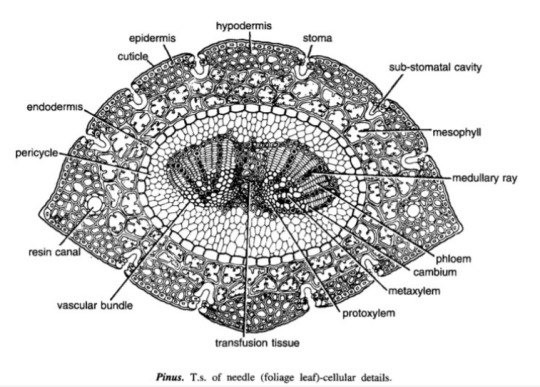
Idk where to find xeric nature info
Williamsoniaceae
Occurrence of Williamsonia
Williamsonia belongs to family Williamsoniaceae of Bennettiales.
It has been reported from Upper Triassic period but was more abundant in Jurassic.
This was earlier discovered under the name Zamia gigas by Willamson in 1870 but has now been named as Williamsonia.
Professor Birbal Sanhi (1932) described W. sewardiana from Rajmahal Hills of Bihar (India).
External Features of Williamsonia
Williamsonia resembled Cycas in appearance, but its best-knows species is W. sewardiana. The plant had an upright, branched, and stout stem covered by persistent leaf bases.
A terminal crown of pinnately compound leaves was present. For the stem genus Bucklandia, Sharma (1991) opined that features of leaf bases such as their shape, size and arrangement pattern are of taxonomic significance.
He observed that leaves in Williamsoniaceae show syndetocheilic stomata with rachis possessing collateral endarch vascular bundles.
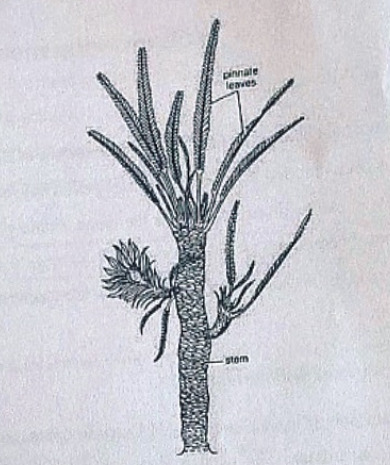
Reproduction in Williamsonia
The fructifications of Williamsonia were large and attained a diameter of about 12 cm.
They were borne on a peduncle.
Many spirally arranged bracts were present around the base of the floral axis.
In W. gigas the cones were present among the crown of leaf bases while in W. sewardinia they were present on the short lateral branches.
Williamsonia plants were unisexual.
Female Flower
The female 'cones' of W. gigas and W. sewardiana have been investigated in detail. Instead of 'strobili' or 'cones', Sporne (1965) proposed to use the term 'flower'.
The conical receptacle was surrounded by many perianth-like bracts. The ovules were stalked.
The apex of the receptacle was naked and sterile. The nucellus was surrounded by a single vascularize integument, which was fused with the nucellus. The nucellus had a well-marked beak and a pollen chamber. In young ovules the micropylar canal was long and narrow.
In mature ovules, the canal widened because of the formation of nucellar plug and disappearance of interlocking cells. In the apical part of the endosperm, Sharma (1979) observed 2 or more archegonia.
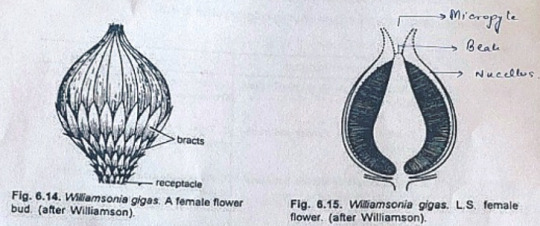
Male Flower
Male flowers consisted of a whorl of microsporophyll's which were united to form a more or less cuplike structure. In majority of the investigates species the sporophylls were un-branched but in some species they were also pinnately branched.
Sitholey and Bose discovered W. santalensis from Upper Gondwana, and observed that microsporophyll's in the species were bifid.
One of the branches of microsporophyll was fertile while the other was sterile. The fertile part has finger-like structures called synangia. Each synangium had two rows of chambers enclosing microsporangia.
The fertile branch of the bifid sporophyll possessed many purse-like capsules, in each of which there were present many monocolpate pollen grains.
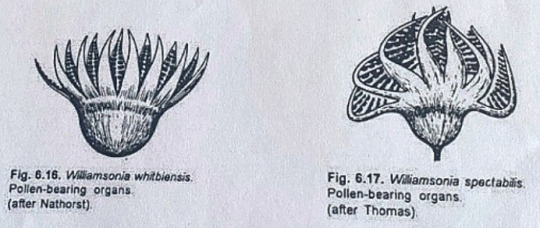
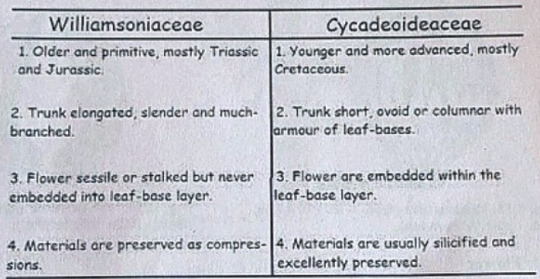
Cycadeoideaceae
Classification:
Division - Cycadeoidophyta
Order - Cycadeoideales
Family - Cycadeoideaceae
Genus - Cycadeoidea
Introduction:
Cycadeoidea is the only genus of family Cycadeoidaceae, represented by thirty species. They are entirely extinct and resemble cycads in the outward stumpy appearance of trunk and an apical crown of pinnate compound leaves. This fossil group of plants flourished during the Triassic to Cretaceous periods of the Mesozoic era. They are reported from various places in the world, in India the Cycadeoidales are found in Rajmahal Hills in Bihar. The petrified trunks of C. entrusca are the oldest fossil ever collected by man.
External Features:
The genus Cycadeoidea had a short, branched, or unbranched spherical, conical, or irregular trunk. The diameter of the trunk is 50cm and the highest rarely reached a meter except in C. jenneyana, it attended the height of several meters. These trunks are covered by rhomboidal leaf bases having multicellular hairs in between. Crown of 10ft long pinnate compound leaves are present at the top.
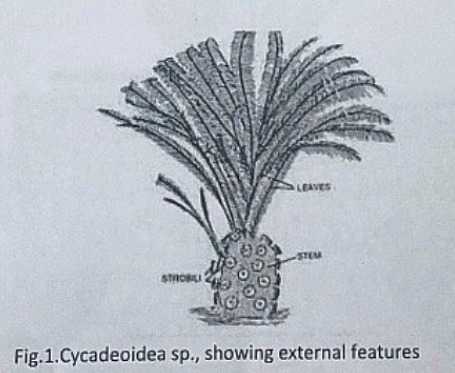
Anatomy of Stem:
The transverse section of the stem shows roughly a circular outline. The epidermis is not very distinct due to the presence of heavy armor of leaf bases. The cortex is parenchymatous and traversed by mucilage canals and numerous leaf traces. The primary vascular structure consists of a ring of endarch, collateral, conjoint, and open vascular bundles encircling the pith. Pith is wide and parenchymatous. A ray-like extension passes between the vascular bundles that make their appearance discrete.
There is a cambium ring with a thin zone of secondary wood. The secondary wood encircles the primary xylem and consists of tracheids with scalariform and bordered pits. The secondary medullary rays traverse the secondary xylem and secondary phloem.
The C-shaped leaf traces arise singly from the primary vascular strand and entering the cortex divided into several masarch strands and enters straight into the leaf.
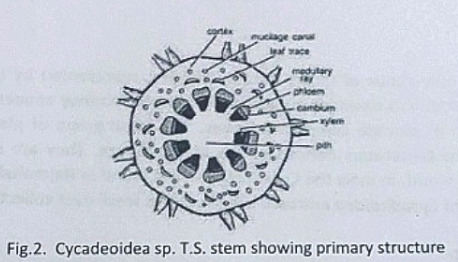
Anatomy of Leaf:
The pinnules show xerophilous structure. The upper and lower epidermis is heavily cutinized and thick walled. The mesophyll cells are distinguished into palisade and spongy parenchyma. The vascular bundles are mesarch and surrounded by bundle sheath.
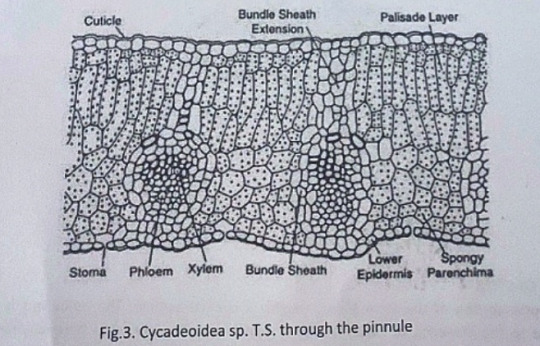
Reproduction:
The reproductive structure is represented by flowers. In most of the species, the flowers are bisexual and arise in the axil of each leaf.
Structure of Flower:
The flowers are bisporangiate, stalked, and partially sunken in the leaf base armor. Rach such mature flower is 5-10cm in diameter and 10cm long. From the base of such flowers about 100 to 150 hairy bracts arise in close spiral little below the apex. These bracts formed a perianth like structure and protect the megasporangiate and microsporangiate parts of a flower. The microsporophyll or androecium forms a whorl united at the base into a sheath. The megasporophyll or gynaecium consists of numerous stalked ovules born around a central receptacle. Between the ovules, interseminal scales with expanded tips are present. These expanded tips fused to form a continuous surface with pores, through which the micropyle of ovules extended. The vascular supply of flowers consists of many branches from leaf traces.
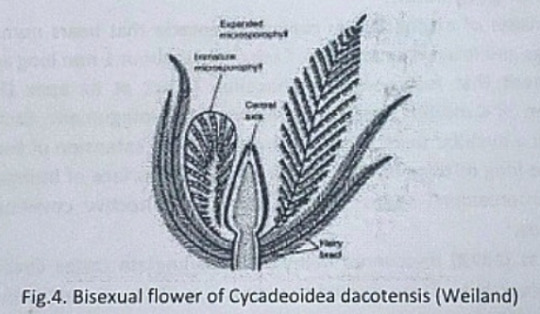
Microsporophyll or Androecium:
The microsporophyll is 10-12cm long, consists of a central rachis bearing numerous pinnae. The pinnae bear two rows of bean-shaped shortly stalked pollen capsules or synangia. These pollen capsules are born on the trabeculae within the fertile region of microsporophyll. A line of dehiscence is also visible at the base of each microsporophyll. This suggest that the entire microsporophyll might have been shed as a unit. The pollen capsule or synangia measures about 3.5x2.5mm and its wall is several layers thick, the outer layer made up of palisade like cells, and the inner layer is made up of thin-walled cells followed by a tapetum. The tapetum was not demarcated. A ring of microsporangia arranged around the periphery of each synangium. The microsporangia dehisce longitudinally and release the microspores into the synangial cavity. At maturity, the synangia liberate these microspores outside by an apical opening that splits into two valves. The liberated microspores or pollens are oval, measures up to 68µ that represents the male gametophytes. Pollen grains of Cycadeoidea are multicellular.
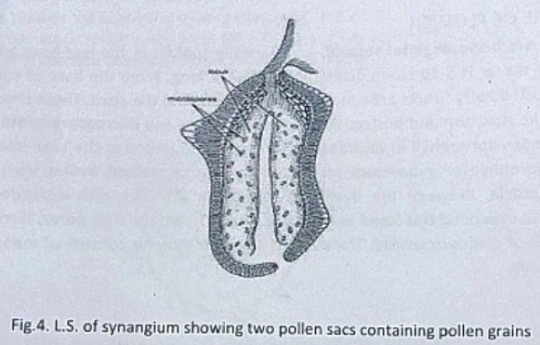
Megasporophyll or Gynoecium
The gynoecium consists of a spherical or conical receptacle that bears numerous stalked orthotropous ovules and interseminal scales. Each ovule is about 1mm long and consists of the single integument that fused with the nucellus except at its apex.
According to Lignier, in C. morieri, nucellus is free from the integument. Each ovule has a pollen chamber and a nucellar beak. This nucellar beak is the extension of the integument. The ovules also have long micropyle, extended from the flat surface of interseminal scales. The fused tips of interseminal scales form an external protective covering or pericarp surrounding the seeds.
Crepet and Delevoryas discovered many of bisporangiate cones from the Cretaceous of black hills. They studied the structure of these ovules in detail. These ovules are urn-shaped and resemble with the ovules of C. wellsii. According to them the micropyle of these ovules are funnel-shaped due to the constriction below the flaring. The inner wall of the micropyle is lined with large cells, considered to be epidermal cells. The integument has three distinct layers. The outer fleshy layer of radially elongated cells, the middle stony layer made up of thick-walled cells, and the inner layer is fleshy.
The young nucellus is made up of thin-walled cells. The cells at the micropylar end are much elongated (80µ long) in comparison to the cells of the chalazal end. The cell at the nucellar tip is pointed up tp whereas cells on either side are bend outward to give the nucellus a distinct shape.
Crepet and Delevoryas reported a linear tetrad or row of three cells in the center of the nucellus.
The seeds are somewhat elongated or oval and possessed two cotyledons.
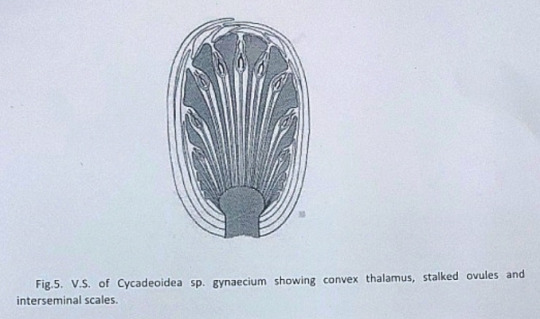
#exam season#send help#biology#notes#science#botany#gymnosperms#pines#pine trees#pine needles#plants#plant science#plant biology#nature#long post
8 notes
·
View notes
Text
PCD is an essential aspect of normal plant development (Figure 22.2), but it can also be induced in response to both abiotic and biotic stress. (...) Examples of such developmental processes include the development of xylem tracheary elements and fibers, leaf shaping during morphogenesis, leaf senescence, and megasporogenesis (see Figure 22.2). (...) As is the case for other examples of PCD shown in Figure 22.2, leaf senescence is an evolutionarily selected process that contributes to the overall fitness of the plant.

"Plant Physiology and Development" int'l 6e - Taiz, L., Zeiger, E., Møller, I.M., Murphy, A.
#book quotes#plant physiology and development#nonfiction#textbook#pcd#programmed cell death#apoptosis#abiotic stress#biotic stress#environmental stress#senescence#leaf senescence#leaves#megaspore#endosperm#aleurone#tracheary elements#root cap#aerenchyma#trichome#morphogenesis#xylem
0 notes
Note
Fun fact about orchids, the reason growing them from seed is hard is because wild orchids are parasites that get their nutrients from fungus they absorb as a seed that feeds them all their lives. That's how some orchid species are able to survive in low light, they don't need to photosynthesize as much as plants without a fungal symbiote (although they still can photosynthesize!) most commercial orchids are grown in a media with just a sugar that feeds the seed, so they don't have fungi to take care of them.
Orchid reproduction is WILD. I got curious about it and looked it up a while back and all this is 100% correct, orchid seeds are like you know what? I don't need an "endosperm" to provide """nutrients""", I'll just rely on a fungus to do all that for me. Orchids looked at other plants who created this novel way of reproduction where everything a baby plant needs is packaged in around them so they are self sufficient and can rely on stored energy to boost their growth until they develop enough to provide their own food, and they went LOL. Suckers. Fungus time.
#asks#orchids#oatplant#the only thing more insane than orchid reproduction is fern reproduction#spores are wild
18 notes
·
View notes
Text
The major metabolic pathway in the starchy endosperm is, as the name implies, starch biosynthesis: the precursor molecule, ADP-glucose, is synthesized in the cytosol and then imported into the amyloplast, where it is enzymatically polymerized into amylose and amylopectin.
"Plant Physiology and Development" int'l 6e - Taiz, L., Zeiger, E., Møller, I.M., Murphy, A.
#book quote#plant physiology and development#nonfiction#textbook#metabolic pathway#starch#endosperm#biosynthesis#adp#glucose#cytosol#amyloplast#amylose#amylopectin#enzymes
0 notes
Text
How Buriti Palm Seeds Prevent Dehydration
How Buriti Palm Seeds Prevent Dehydration https://ift.tt/ESinmrw The seeds of buriti (Mauritia flexuosa), an emblematic palm of South American palm swamps, are known to lose viability when they dry out. Still, they can persist in the soil for a long time, an unusual ability for desiccation-sensitive seeds. Dias and colleagues conducted a thorough study of buriti seed physiological and anatomical changes in response to water stress. The team exposed buriti seeds to different levels of water stress in the lab. They looked at changes in the seeds’ structure and chemistry using various microscopy techniques and biochemical tests. Just like a sponge, the endosperm and mucilage reserves of buriti seeds were found to store great amounts of water. This allows the seeds to stay hydrated even when the environment is very dry. The seeds are also rich in phenolic compounds that allow them to adjust their metabolism during drought periods. The study by Dias and colleagues provides fascinating insights into the mechanisms that allow the desiccation-sensitive seeds of Mauritia flexuosa to persist in the soil and grow in diverse environments across South America. Such information would be key to better understanding the potential effects of climate change on the regeneration of this species, which has such an intricate relationship with water. Dias, G.P., Ribeiro, L.M., Mazzottini-dos-Santos, H.C., Nunes, Y.R.F. and França, M.G.C., 2024. Water stress resilience in Mauritia flexuosa (Arecaceae) embryos: New insights into the persistence of recalcitrant seed banks. Environmental and Experimental Botany, 105930. https://doi.org/10.1016/j.envexpbot.2024.105930 ($) Cross-posted to Bluesky, Mastodon & Threads. The post How Buriti Palm Seeds Prevent Dehydration appeared first on Botany One. via Botany One https://botany.one/ October 23, 2024 at 04:30AM
3 notes
·
View notes
Text
Reproduction in Flowering PlantsFlowering plants, also known as angiosperms, exhibit a diverse array of reproductive strategies, encompassing both sexual and asexual mechanisms.
These mechanisms ensure the continuation of the species and contribute to their evolutionary success.
Sexual Reproduction:
Flower Formation: The reproductive structures of flowering plants are housed within specialized organs called flowers. Flowers typically consist of four main parts: sepals, petals, stamens (male reproductive organs), and pistils (female reproductive organs).
Pollination: Pollination is the transfer of pollen grains from the male reproductive organ (stamen) to the female reproductive organ (pistil) of a flower. This can occur through various agents, including wind, water, insects, birds, and mammals.
Fertilization: Upon reaching the stigma (the receptive part of the pistil), pollen grains germinate and grow pollen tubes, which penetrate the style and reach the ovary. Fertilization occurs when sperm nuclei from pollen grains fuse with egg cells within the ovules, forming zygotes. This process gives rise to seeds.Seed Formation: After fertilization, the ovule develops into a seed, consisting of the embryo, endosperm (nutrient reserve), and seed coat (protective covering). The ovary, which housed the ovules, typically matures into a fruit.
Seed Dispersal: Fruits aid in the dispersal of seeds, ensuring that they are carried away from the parent plant and dispersed over a wide area. This enhances the chances of germination and the establishment of new plants.
Asexual Reproduction:Vegetative Propagation: Many flowering plants have the ability to reproduce asexually through vegetative propagation. This process involves the growth of new plants from specialized vegetative structures such as stems, roots, or leaves.
Runners and Stolons: Some plants produce specialized horizontal stems called runners or stolons, which grow above or below the ground and give rise to new plants at nodes along their length. Examples include strawberry plants and certain species of grasses.
Rhizomes: Rhizomes are underground stems that spread horizontally and give rise to new shoots and roots at nodes. Plants such as ginger, bamboo, and irises reproduce through rhizomes.Bulbs, Corms, and Tubers: Bulbs, corms, and tubers are modified underground storage organs that can give rise to new plants. Examples include onions (bulbs), crocuses (corms), and potatoes (tubers).
Tissue Culture: In modern agriculture and horticulture, tissue culture techniques are employed to propagate plants rapidly from small amounts of plant tissue. This method is particularly useful for producing large numbers of genetically identical plants, such as in the case of ornamental plants and crops.
Conclusion:Reproduction in flowering plants is a complex process involving both sexual and asexual mechanisms. Sexual reproduction, facilitated by flowers, ensures genetic diversity through the formation of seeds. Asexual reproduction offers advantages such as rapid propagation and the production of genetically identical offspring. Together, these reproductive strategies contribute to the survival and proliferation of flowering plant species in diverse habitats worldwide.
2 notes
·
View notes
Text


The Story of Chocolate for Valentines Day.
If you are gifting chocolate to a loved one or yourself on Valentines Day, make sure to learn the incredible story of the Cacao tree (Theobroma cacao) and the human race’s love affair with this plant.
The chocolate candy many of us enjoy on Valentines Day starts out with raw materials from a specific plant, the Cacao tree. In the wild, the Cacao tree is found over a large geographic area encompassing south eastern Mexico to the Amazon Basin. Cacao may have originally evolved in the region around Colombia, Ecuador, and Peru, or this area may have been a refuge for the species during the Ice Age 21000 years ago when natural climate change reduced its habitat.
Cacao is a member of the Malvaceae plant family, which includes hibiscus, hollyhock, cotton, and the Baobab tree. There are 20 species in the Theobroma genus, but T. cacao is the only species currently used for chocolate production. The plant is a spindly evergreen tree evolved to grow in the shade of towering rainforest trees. The flowers, which are mostly pollinated by midges in the tree’s native range, are small, pale-coloured, and sprout directly from the sides of the trunk and branches. The most visually arresting feature of the tree is the large, egg-shaped seed pods.
Chocolate begins with the Cacao seeds inside the seed pods. The seeds are surrounded by white pulpy tissue called “mucilage” which tastes like tropical fruit and is eaten by rainforest animals like monkeys and sloths. It is thought that indigenous Americans originally harvested cacao pods for the tasty pulp and much later discovered chocolate-making. The pulp surrounding the seeds is fermented, and the resulting chemical changes and heat generated by the microbial action changes the tissue inside the seed from bitter and astringent to the distinctive chocolatey flavour.
The seeds are cleaned, dried, and roasted before the seed coats are cracked open to reveal the nibs. Cacao nibs are the endosperm of the cacao seed which are ground to produce cacao mass. The cacao mass is liquified by heating and the resulting chocolate liqueur can be processed into the cacao butter and cacao solids. Different chocolate products are made by recombining the butter and solids in varying proportions.
Chocolate is a sweet treat, and those are unhealthy indulgences – right? Not necessarily with cacao! In general, chocolate products with more cacao solids and less cacao butter are healthier since they contain more of the original plant chemicals and less fatty cacao butter, along with other additives. Dark chocolate is rich in iron, magnesium, copper, manganese, potassium, phosphorus, zinc, selenium, and iron. Moderate dark chocolate consumption may help regulate healthy cholesterol, reduce heart disease risk, and improve brain function.
Join next week to learn about how cacao has influenced culture from ancient times to now.
#katia plant scientist#botany#plant biology#plants#plant science#chocolate#cacao#theobroma cacao#chocolates#cacao tree#trees#plant identification#foliage#cacao pod#seed pods#chocolate making#chocolate tree#valentines day#lovecore#hearts#love#valentines aesthetic
3 notes
·
View notes